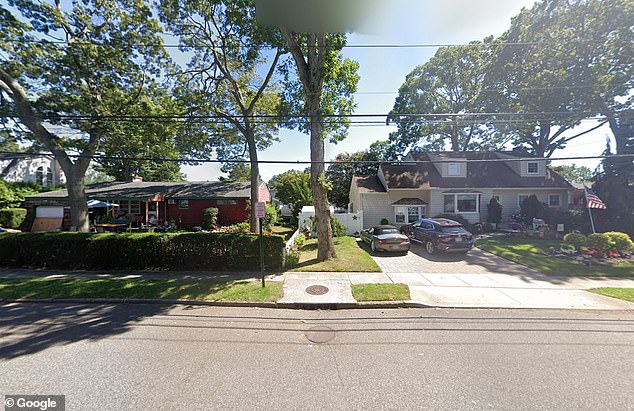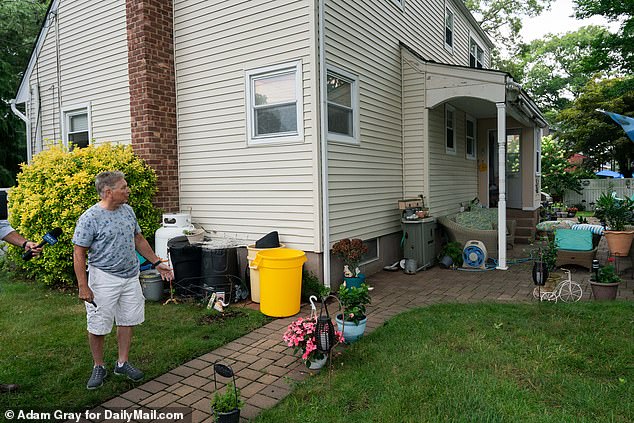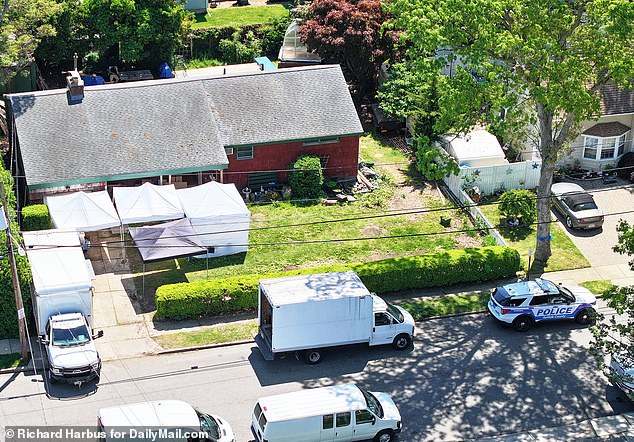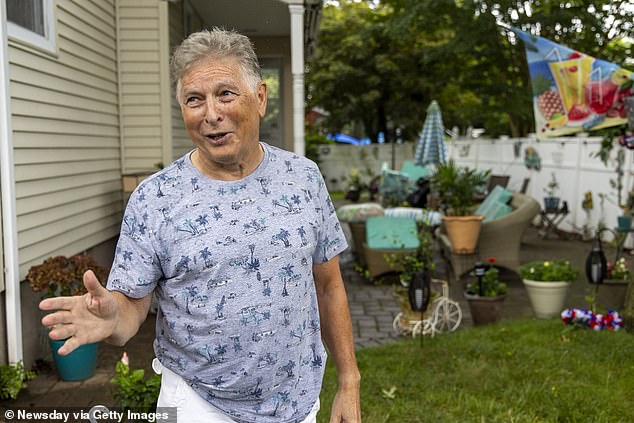A former New York City firefighter has revealed that he spent nearly three decades living next door to the prime suspect in the Gilgo Beach serial murders.
Etienne de Villiers, 69, and his wife Patricia, 66, lived next door to suspected killer Rex Heuermann, accused of killing six women who disappeared between 1993 and 2010.
All the while, de Villiers, known as “Frenchy” at his firehouse, believed his neighbor was “creepy” but harmless, ever since he moved into his home on First Avenue in the small town of 17,000 in 1995 with his wife, Patricia.
Heuermann and de Villiers lived next door to each other in the Long Island town of Massapequa Park since 1995.
De Villiers was initially shocked to learn of his neighbour’s alleged crimes, but quickly recalled incidents with Heuermann that had left him feeling uneasy.
Etienne de Villiers, 69, lived next door to Rex Heuermann, an architect who has pleaded not guilty to five murders and is suspected of a sixth.

Rex Heuermann and de Villiers lived next door to each other in the town of Massapequa Park, Long Island, since 1995.
She described Heuermann as an imposing figure who tried to have awkward conversations with his wife, especially when De Villiers was away from home on duty.
“Every time she was there and I was at the fire station working, Rex would look over the fence and talk to her,” de Villiers said. The Daily Beast.
But Patricia eventually told her husband that Heuermann’s behavior made her nervous.
There was a time when he would look over the fence and watch her sunbathe, trying to make small talk, when the couple first moved into the neighborhood.
“He kept saying, ‘I was 6’4″ and 250 pounds,’ and trying to start conversations with her,” De Villiers told Fox News.
De Villiers eventually confronted Heuermann and asked him to stop. Perhaps surprisingly, Heuermann complied without resistance.
“I literally threatened the guy,” de Villiers said. “I thought if I had to fight him, I had to fight him. I don’t care how big he is. I said, ‘Don’t do it to me…’ I said, ‘STOP!’
“It was unpleasant, he complied. He stopped and did not argue with me,” de Villiers said.
“He said, ‘I’m not going to do it anymore,’ and he immediately backed out. So I said, ‘Okay.'”
“When I had that altercation with him, I basically threatened him to stop leering at my wife. He backed off. I didn’t see the violence coming because he didn’t seem violent. I mean, he was just weird to look at, huge,” de Villiers recalled.
“But he never became more violent towards me or anyone else that I could tell him,” she said. “It’s scary now when you stop to think that all the girls look like my wife.”

Etienne de Villiers, 69, and his wife Patricia, 66, lived next door to Heuermann.

The home of former FDNY firefighter Etienne de Villiers and his wife, Patricia, is seen on the right, while that of Gilgo Beach serial killer suspect Rex Heuermann is seen on the left.

Heuermann, who is 1.93 metres tall, used to look over the fence and try to make small talk while Patricia sunbathed when De Villiers was on duty at the fire station.
Over the years, their interactions remained brief but friendly, even if they were limited to brief chats as De Villiers walked to his car parked in the driveway.
“We didn’t have a beer together or play cards or anything like that. But every time I went out to get my car, he and I would always say to each other, ‘How are you?'” De Villiers recalls. “That’s more or less how it was for the next 30 years.”
Heuermann often mentioned his size, his weight of 113kg, his collection of guns and his fondness for hunting, even saying that he had a security door to “protect his guns.” This surprised De Villiers, given the state of disrepair in which his house was found.
“He was a strange and odd guy, but never violent,” de Villiers said. “We talked almost every day. He was always kind and respectful. I was shocked by the violence. I really feel bad for the kids.”
Despite having grown up and lived there for years, Heuermann had let his house fall into disrepair, even though he was an architect. De Villiers compared him to a shoemaker with holes in his shoes.
De Villiers’ relationship with Heuermann seems to have been unique in the neighbourhood, as many others avoided him.
“The neighbour who was on the other side of the house had put up some huge trees so you couldn’t see his house, so he didn’t have any contact with the guy,” de Villiers said. “So it’s sad to say that pretty much the only one who spoke to that guy was me.”
Other neighbors believed the suspected serial killer was a quiet family man who could often be seen doing repairs in his garage while keeping to himself.

This realization has caused De Villiers to reflect on the contrast between his life’s work saving lives as a firefighter and Heuermann’s alleged crimes.
De Villiers also noticed that Heuermann’s friends appeared disheveled, unlike the typical Massapequa resident.
“He seemed like a pretty despicable guy. You could pick them up and put them in a trailer park,” de Villiers told The Daily Beast.
Heuermann had been married to Asa Ellerup. Together they had a daughter, Victoria, while Ellerup’s son, Christopher Sheridan, also lived with them.
Christopher, who has developmental disabilities, seemed extremely withdrawn and friendless as he grew up, de Villiers said.
De Villiers, who served at Ground Zero after 9/11, recently learned of Heuermann’s alleged “post-event” to-do list, which detailed methods designed to prevent bodies from being found and identified.
The document, recovered from one of Heuermann’s computers, described gruesome steps such as “removing identifying marks” and “removing the head and hands.”
It was in 2010 when Suffolk County Police Officer John Mallia discovered the remains of Melissa Barthelemy, one of the Gilgo Four, while searching for a missing sex worker.
The discovery led to the discovery of more victims and the identification of a new serial killer on Long Island.
Initially, investigators suspected a senior police officer, but DNA evidence pointed to Heuermann.
Heuermann was initially charged with the murders of three women: Megan Waterman, Melissa Barthelemy and Amber Costello. The victims had disappeared between 2007 and 2010.
In January, he was also charged with the murder of a fourth victim, Maureen Brainard-Barnes.

Rex Heuermann’s neighbor Etienne Devilliers shows where Heuermann used to look over the backyard fence at his wife sunbathing at their home in Massapequa Park, New York.

Despite being an architect, Heuermann allowed his house to fall into disrepair over the course of his 30 years.

Then last month, Heuermann was charged with killing two more women, including Sandra Costilla, murdered in 1993, and Jessica Taylor, whose torso was found in 2003.
De Villiers recalls police coming to his door early one morning in July 20213 and asking him to move his cars.
He complied and, watching the news, learned that Heuermann was the suspect in Gilgo’s murder. He was stunned, given the years they had been interacting as neighbors.
De Villiers shared a conversation where Heuermann’s son, Christopher, expressed disbelief over his father’s guilt.
The neighbour reassured him, stressing the principle of innocence until proven guilty and also felt sorry for Heuermann’s wife, Victoria.
It was again in May this year, just as in July last year, that helicopters flew overhead and police patrol cars again blocked access to the suburban area.
A second search uncovered even more evidence and saw Heuermann charged with the additional murders.
The indictment describes his meticulous planning and brutal methods.
This has left De Villiers reflecting on the contrast between his life’s work saving lives as a firefighter and Heuermann’s alleged crimes, destroying families in the process.
(tags to translate)dailymail


